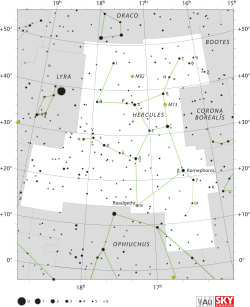Zeta Herculis

| |
| Observation data Epoch J2000 Equinox J2000 | |
|---|---|
| Constellation | Hercules |
| Right ascension | 16h 41m 17.16104 s[1] |
| Declination | +31° 36′ 09.7873″[1] |
| Apparent magnitude (V) | 2.81[2] |
| Characteristics | |
| Spectral type | F9 IV + G7 V[3] |
| U−B color index | +0.21[2] |
| B−V color index | +0.65[2] |
| Variable type | Suspected |
| Astrometry | |
| Radial velocity (Rv) | –68.43[4] km/s |
| Proper motion (μ) | RA: –461.52[1] mas/yr Dec.: +342.28[1] mas/yr |
| Parallax (π) | 93.32 ± 0.47[1] mas |
| Distance | 35.0 ± 0.2 ly (10.72 ± 0.05 pc) |
| Absolute magnitude (MV) | 2.65[5] |
| Orbit[6] | |
| Period (P) | 34.45 yr |
| Semi-major axis (a) | 1.33" |
| Eccentricity (e) | 0.46 |
| Inclination (i) | 131° |
| Longitude of the node (Ω) | 50° |
| Periastron epoch (T) | 1967.7 |
| Argument of periastron (ω) (secondary) | 111° |
| Details | |
| ζ Her A | |
| Mass | 1.45 ± 0.01[7] M☉ |
| Radius | 2.56–2.61[7] R☉ |
| Luminosity | 6.55 ± 0.39[7] L☉ |
| Surface gravity (log g) | 3.4–3.6[7] cgs |
| Temperature | 5,820 ± 50[7] K |
| Metallicity [Fe/H] | 0.04 ± 0.003[7] dex |
| Rotation | 34.4 years[5] |
| Rotational velocity (v sin i) | 4.8[5] km/s |
| Age | 6.2[8] Gyr |
| ζ Her B | |
| Mass | 0.98 ± 0.02[7] M☉ |
| Radius | 0.915–0.920[7] R☉ |
| Luminosity | 0.62 ± 0.06[7] L☉ |
| Temperature | 5,300 ± 150[7] K |
| Other designations | |
Zeta Herculis (ζ Her, ζ Herculis) is a multiple star system in the constellation Hercules. It has a combined apparent visual magnitude of 2.81,[2] which is readily visible to the naked eye. Parallax measurements put it at a distance of about 35.0 light-years (10.7 parsecs) from Earth.[1]
The primary member is a subgiant star that is somewhat larger than the Sun and has just begun to evolve away from the main sequence as the supply of hydrogen at its core becomes exhausted. It is orbited by a smaller companion star at a mean angular separation of 1.5 arcseconds, which corresponds to a physical separation of about 15 Astronomical Units.[7] This distance is large enough so that the two stars do not have a significant tidal effect on each other. The stars orbit each other over a period of 34.45 years, with a semi-major axis of 1.33" and an eccentricity of 0.46.[6]
Component A has a stellar classification of F9 IV.[3] It has about 2.6 times the radius of the Sun and 1.45 times the Sun's mass. This star is radiating more than six times the luminosity of the Sun at an effective temperature of 5,820 K. The secondary component is about the same size and mass as the Sun, with an effective temperature of 5,300 K. Both stars are rotating slowly.[7] There may be a faint third member of this system, although little is known about it.[9]
This system forms part of the Zeta Herculis moving group of stars. This group includes: φ2 Pavonis, ζ Reticuli, 1 Hydrae, Gl 456, Gl 678, and Gl 9079.[10]
References
- 1 2 3 4 5 6 van Leeuwen, F. (November 2007), "Validation of the new Hipparcos reduction", Astronomy and Astrophysics, 474 (2): 653–664, arXiv:0708.1752
 , Bibcode:2007A&A...474..653V, doi:10.1051/0004-6361:20078357
, Bibcode:2007A&A...474..653V, doi:10.1051/0004-6361:20078357 - 1 2 3 4 Johnson, H. L.; et al. (1966), "UBVRIJKL photometry of the bright stars", Communications of the Lunar and Planetary Laboratory, 4 (99), Bibcode:1966CoLPL...4...99J
- 1 2 Edwards, T. W. (April 1976), "MK classification for visual binary components", Astronomical Journal, 81: 245–249, Bibcode:1976AJ.....81..245E, doi:10.1086/111879
- ↑ Tokovinin, A. A.; Smekhov, M. G. (January 2002), "Statistics of spectroscopic sub-systems in visual multiple stars", Astronomy and Astrophysics, 382: 118–123, Bibcode:2002A&A...382..118T, doi:10.1051/0004-6361:20011586
- 1 2 3 Pizzolato, N.; Maggio, A.; Sciortino, S. (September 2000), "Evolution of X-ray activity of 1-3 Msun late-type stars in early post-main-sequence phases", Astronomy and Astrophysics, 361: 614–628, Bibcode:2000A&A...361..614P
- 1 2 Söderhjelm, Staffan (January 1999), "Visual binary orbits and masses POST HIPPARCOS", Astronomy and Astrophysics, 341: 121–140, Bibcode:1999A&A...341..121S
- 1 2 3 4 5 6 7 8 9 10 11 12 Morel, P.; et al. (November 2001), "The zeta Herculis binary system revisited. Calibration and seismology", Astronomy and Astrophysics, 379: 245–256, arXiv:astro-ph/0110004
 , Bibcode:2001A&A...379..245M, doi:10.1051/0004-6361:20011336
, Bibcode:2001A&A...379..245M, doi:10.1051/0004-6361:20011336 - ↑ Barry, Don C.; Cromwell, Richard H.; Hege, E. Keith (April 1987), "Chromospheric activity and ages of solar-type stars", Astrophysical Journal, Part 1, 315: 264–272, Bibcode:1987ApJ...315..264B, doi:10.1086/165131
- ↑ Zhuchkov, R. Ya.; Orlov, V. V.; Rubinov, A. V. (May 2006), "Multiple stars with low hierarchy: stable or unstable?", Publications of the Astronomical Observatory of Belgrade, 80: 155–160, Bibcode:2006POBeo..80..155Z
- ↑ de Mello, G. F. Porto; da Silva, L. (1991), "On the physical existence of the Zeta HER moving group - A detailed analysis of Phi exp 2 Pavonis", Astronomical Journal, 102: 1816–1825, Bibcode:1991AJ....102.1816P, doi:10.1086/116006
External links
- "Gl 635". ARICNS. Retrieved 2006-07-27.
- "HD 150680 — Spectroscopic binary". SIMBAD. Retrieved 2006-07-27.
- Prof. Jim Kaler. "Zeta Herculis". Stars. Retrieved 2006-07-27.